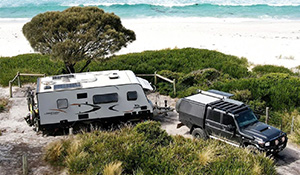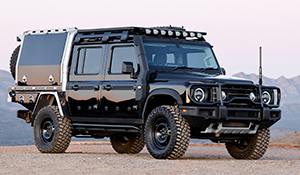Gear You Need: Mud

There’s no doubt young’uns are attracted to mud. You know the ones I’m talking about; they usually drive old HiLuxes wearing 35s that are caked in mud from the previous weekend’s bush adventure. The mud is worn like a badge of honour and the only clean part of the vehicle is the section of windscreen that’s been cleared away by a few sweeps of the wiper blades.
The older you get, however, the more chance your vehicle will look relatively clean, even after a wet weekend away in the bush, because by now you know how hard it can be to clean mud off a vehicle, and just how damaging it can be if you leave it there. But sometimes there’s no avoiding the gooey mess, so it pays to have the right gear for those times when your squeaky clean 4x4 is going to have to take a mud bath.


Water Damage
The first bit of equipment you’ll need before plunging your rig into the mud is a big stick. If you’re faced with a muddy section along an otherwise seemingly clear track, you’ll want to know how deep it is before you drive into it, and if there are any obstacles. The best way to do this is to walk alongside the muddy puddle and poke at it with a stick to check for depth and feel for obstacles.
If the mud is deep enough to potentially exceed the wading depth of your vehicle, and there’s no alternative route, your rig will need to be equipped with a snorkel and breather extensions for the diffs, gearbox and transfer case.
When choosing a snorkel go for a renowned brand such as Safari, Airtec, Ironman 4x4 or Airflow. These will have been specifically designed to suit the model and specification of your vehicle, and they are made from UV-resistant materials and have quality fittings to ensure water and mud stays out of your engine.
Most four-wheel drive specialists offer breather extension kits to keep water and mud out of your driveline components, and these should be located high-up in the engine bay, usually on the firewall. Some extensions are fitted with one-way filters to ensure no contaminants are sucked into the diffs, gearbox or transfer case from pressure changes that occur when these often hot mechanical components are submerged in cold mud.
To minimise the amount of mud and water running through your engine bay, you can fit a wading blanket to the front of your vehicle before pushing through a muddy section of track, especially if it’s very deep. But even then some components under the bonnet might need additional protection…
If you drive an old-school petrol 4x4, you’ll probably be familiar with the old rubber-glove-over-the-distributor trick. Even with modern petrol and diesel 4x4s, there are certain electrical components that do not like mud and water, so have a look around the engine bay and see what items, such as the ECU or fuse boxes, can be sealed with silicon, covered with a plastic bag, or sprayed liberally with a water dispersant such as WD-40 before you take the plunge.

Tyres and Suspension
Mud tyres are obviously going to work best when driving in mud due to their open tread blocks that allow them to bite into the surface and more easily clean away mud as they rotate, but there are compromises: those open tread blocks can be noisy on the road; they will wear faster than less aggressive tyres; and wet-weather grip on hard surfaces will not be as good as it is with road tyres.
If you’re not willing to accept the compromises of aggressive mud tyres, you’d be surprised at how far you can get in muddy conditions with an all-terrain tread pattern or even road tyres simply by lowering air pressures. Lower pressures will lengthen the tyre’s footprint and allow the tyre to bag out more, hopefully giving more purchase on the mud. Around 22-28psi is a good pressure for most vehicles when driving in mud, especially if it has a soft base, but if the vehicle is carrying a heavy load you may have to keep pressures a little higher. If you get stuck, and you can access the valve stems, you can drop pressures further, which will sometimes allow you to drive out of your predicament without resorting to recovery gear.
If you’re going play around with tyre pressures for mud driving, you’ll need to carry a tyre pressure gauge, a tyre deflator and an air compressor. It’s also a good idea to throw in a tyre repair kit.
One of the reasons a 4x4 can get stuck in the mud is when it runs out of ground clearance. When this happens, mud builds up under the vehicle and stops forward progress, and the more you try to drive out the deeper the vehicle can sink. The more ground clearance under the vehicle, the further it will go before it gets stuck, which is one of the reasons many four-wheel drivers fit larger diameter tyres and a raised suspension. Of course, on heavily trafficked muddy tracks, modified vehicles can make the ruts even deeper and the crown of the track even higher, which will make it more difficult for standard 4x4s to get through. In most states of Australia, the maximum permissible vehicle lift is 75m, which can be achieved through a 50mm suspension lift and a 25mm increase from fitting larger diameter tyres.
Even with a 75mm lift, your vehicle can still bottom out in deep mud, so it should also be equipped with suitable underbody protection, such as bash plates beneath vulnerable components including the radiator, engine sump, gearbox and transfer case. After all, mud might be soft, but hidden obstacles in the mud might not be.

Traction aids
When you drive through mud you want to employ all the traction aids available to you. If you drive a modern 4x4 with an electronically controlled terrain management system, make sure you select the ‘mud’ mode before driving into mud. This will tailor various parameters such as throttle and transmission response to best suit the conditions.
On some vehicles it’s also advisable to engage the OE rear diff lock before diving into mud to complement the electronic traction aids, but on others this will deactivate the traction control system, potentially reducing the vehicle’s capability in mud. Make sure you’re aware of how these systems operate on your vehicle.
If your vehicle is equipped with aftermarket diff locks, engage them before tackling deep mud; if you can ensure all four wheels are driving all of the time, you’ll have the best chance of making it through.


Recovery equipment
Some of the most useful things you can have in your recovery kit when driving in mud include a long-handle shovel, a pair (or more) of recovery tracks and, if travelling with other vehicles, a snatch strap and shackles. Of course, your vehicle will also need to be equipped with rated recovery points front and rear.
A winch is also handy when mud driving, not just to get you out of the mud but also to make it easier to work your way through tricky muddy tracks without mechanically abusing your vehicle or causing undue track damage. Your winch will need to be accompanied by associated equipment including a tree trunk protector, winch extension strap, snatch blocks, rated shackles, and a winch-cable damper.


Clean Up
Getting stuck in the mud can be a messy affair, so it’s always a good idea to have a pair of mud boots handy for when you need to get out of the vehicle to conduct a recovery operation. You’ll also need a pair of tough work gloves and, if you’re a bit precious about your vehicle’s interior, make sure you have quality rubber floor mats with raised edges and waterproof seat covers.
You’ll want to clean up your vehicle as soon as practicable once you’ve finished playing in the mud. A high-pressure washer is the best way to clean the underside of the vehicle. Ensure there’s no mud build-up inside the wheels (which can throw them out of balance), and clean around mechanical components such as the underside of the engine, the gearbox, the transfer case, the diffs and suspension components. If it’s really caked on, apply a chemical cleaner such as Chemtech CT18 truck wash prior to using the high-pressure washer.
You’ll also want to thoroughly clean your vehicle’s painted surfaces, which can be easily damaged by the abrasive particles in mud, and don’t forget to also clean and dry your recovery gear so it’s ready to use the next time you go bush.











